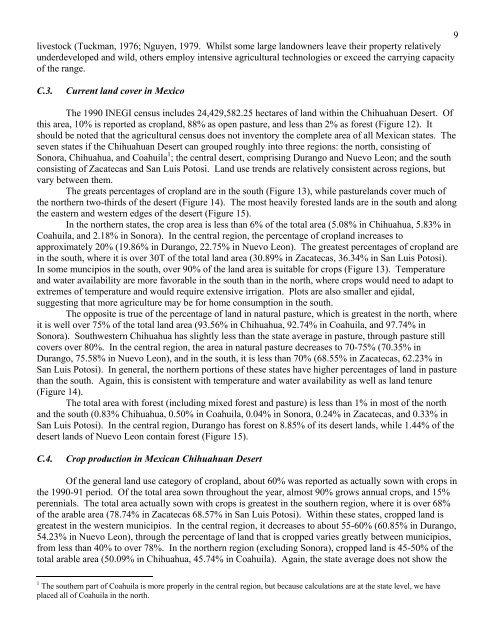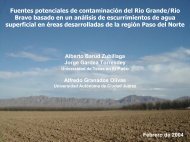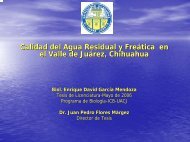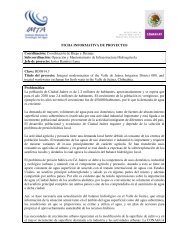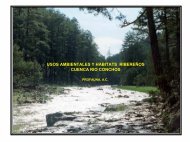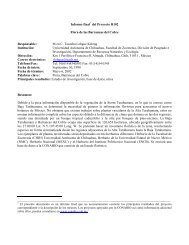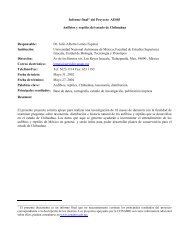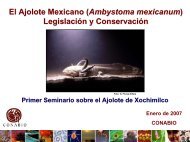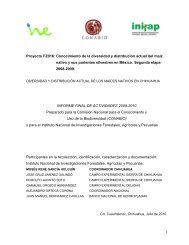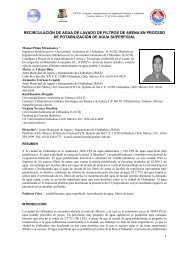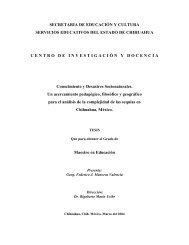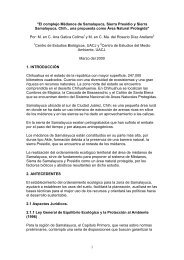land use and land tenure change in the - El Colegio de Chihuahua
land use and land tenure change in the - El Colegio de Chihuahua
land use and land tenure change in the - El Colegio de Chihuahua
You also want an ePaper? Increase the reach of your titles
YUMPU automatically turns print PDFs into web optimized ePapers that Google loves.
9livestock (Tuckman, 1976; Nguyen, 1979. Whilst some large <strong>l<strong>and</strong></strong>owners leave <strong>the</strong>ir property relativelyun<strong>de</strong>r<strong>de</strong>veloped <strong>and</strong> wild, o<strong>the</strong>rs employ <strong>in</strong>tensive agricultural technologies or exceed <strong>the</strong> carry<strong>in</strong>g capacityof <strong>the</strong> range.C.3.Current <strong>l<strong>and</strong></strong> cover <strong>in</strong> MexicoThe 1990 INEGI census <strong>in</strong>clu<strong>de</strong>s 24,429,582.25 hectares of <strong>l<strong>and</strong></strong> with<strong>in</strong> <strong>the</strong> <strong>Chihuahua</strong>n Desert. Ofthis area, 10% is reported as crop<strong>l<strong>and</strong></strong>, 88% as open pasture, <strong>and</strong> less than 2% as forest (Figure 12). Itshould be noted that <strong>the</strong> agricultural census does not <strong>in</strong>ventory <strong>the</strong> complete area of all Mexican states. Theseven states if <strong>the</strong> <strong>Chihuahua</strong>n Desert can grouped roughly <strong>in</strong>to three regions: <strong>the</strong> north, consist<strong>in</strong>g ofSonora, <strong>Chihuahua</strong>, <strong>and</strong> Coahuila 1 ; <strong>the</strong> central <strong>de</strong>sert, compris<strong>in</strong>g Durango <strong>and</strong> Nuevo Leon; <strong>and</strong> <strong>the</strong> southconsist<strong>in</strong>g of Zacatecas <strong>and</strong> San Luis Potosi. L<strong>and</strong> <strong>use</strong> trends are relatively consistent across regions, butvary between <strong>the</strong>m.The greats percentages of crop<strong>l<strong>and</strong></strong> are <strong>in</strong> <strong>the</strong> south (Figure 13), while pasture<strong>l<strong>and</strong></strong>s cover much of<strong>the</strong> nor<strong>the</strong>rn two-thirds of <strong>the</strong> <strong>de</strong>sert (Figure 14). The most heavily forested <strong>l<strong>and</strong></strong>s are <strong>in</strong> <strong>the</strong> south <strong>and</strong> along<strong>the</strong> eastern <strong>and</strong> western edges of <strong>the</strong> <strong>de</strong>sert (Figure 15).In <strong>the</strong> nor<strong>the</strong>rn states, <strong>the</strong> crop area is less than 6% of <strong>the</strong> total area (5.08% <strong>in</strong> <strong>Chihuahua</strong>, 5.83% <strong>in</strong>Coahuila, <strong>and</strong> 2.18% <strong>in</strong> Sonora). In <strong>the</strong> central region, <strong>the</strong> percentage of crop<strong>l<strong>and</strong></strong> <strong>in</strong>creases toapproximately 20% (19.86% <strong>in</strong> Durango, 22.75% <strong>in</strong> Nuevo Leon). The greatest percentages of crop<strong>l<strong>and</strong></strong> are<strong>in</strong> <strong>the</strong> south, where it is over 30T of <strong>the</strong> total <strong>l<strong>and</strong></strong> area (30.89% <strong>in</strong> Zacatecas, 36.34% <strong>in</strong> San Luis Potosi).In some muncipios <strong>in</strong> <strong>the</strong> south, over 90% of <strong>the</strong> <strong>l<strong>and</strong></strong> area is suitable for crops (Figure 13). Temperature<strong>and</strong> water availability are more favorable <strong>in</strong> <strong>the</strong> south than <strong>in</strong> <strong>the</strong> north, where crops would need to adapt toextremes of temperature <strong>and</strong> would require extensive irrigation. Plots are also smaller <strong>and</strong> ejidal,suggest<strong>in</strong>g that more agriculture may be for home consumption <strong>in</strong> <strong>the</strong> south.The opposite is true of <strong>the</strong> percentage of <strong>l<strong>and</strong></strong> <strong>in</strong> natural pasture, which is greatest <strong>in</strong> <strong>the</strong> north, whereit is well over 75% of <strong>the</strong> total <strong>l<strong>and</strong></strong> area (93.56% <strong>in</strong> <strong>Chihuahua</strong>, 92.74% <strong>in</strong> Coahuila, <strong>and</strong> 97.74% <strong>in</strong>Sonora). Southwestern <strong>Chihuahua</strong> has slightly less than <strong>the</strong> state average <strong>in</strong> pasture, through pasture stillcovers over 80%. In <strong>the</strong> central region, <strong>the</strong> area <strong>in</strong> natural pasture <strong>de</strong>creases to 70-75% (70.35% <strong>in</strong>Durango, 75.58% <strong>in</strong> Nuevo Leon), <strong>and</strong> <strong>in</strong> <strong>the</strong> south, it is less than 70% (68.55% <strong>in</strong> Zacatecas, 62.23% <strong>in</strong>San Luis Potosi). In general, <strong>the</strong> nor<strong>the</strong>rn portions of <strong>the</strong>se states have higher percentages of <strong>l<strong>and</strong></strong> <strong>in</strong> pasturethan <strong>the</strong> south. Aga<strong>in</strong>, this is consistent with temperature <strong>and</strong> water availability as well as <strong>l<strong>and</strong></strong> <strong>tenure</strong>(Figure 14).The total area with forest (<strong>in</strong>clud<strong>in</strong>g mixed forest <strong>and</strong> pasture) is less than 1% <strong>in</strong> most of <strong>the</strong> north<strong>and</strong> <strong>the</strong> south (0.83% <strong>Chihuahua</strong>, 0.50% <strong>in</strong> Coahuila, 0.04% <strong>in</strong> Sonora, 0.24% <strong>in</strong> Zacatecas, <strong>and</strong> 0.33% <strong>in</strong>San Luis Potosi). In <strong>the</strong> central region, Durango has forest on 8.85% of its <strong>de</strong>sert <strong>l<strong>and</strong></strong>s, while 1.44% of <strong>the</strong><strong>de</strong>sert <strong>l<strong>and</strong></strong>s of Nuevo Leon conta<strong>in</strong> forest (Figure 15).C.4.Crop production <strong>in</strong> Mexican <strong>Chihuahua</strong>n DesertOf <strong>the</strong> general <strong>l<strong>and</strong></strong> <strong>use</strong> category of crop<strong>l<strong>and</strong></strong>, about 60% was reported as actually sown with crops <strong>in</strong><strong>the</strong> 1990-91 period. Of <strong>the</strong> total area sown throughout <strong>the</strong> year, almost 90% grows annual crops, <strong>and</strong> 15%perennials. The total area actually sown with crops is greatest <strong>in</strong> <strong>the</strong> sou<strong>the</strong>rn region, where it is over 68%of <strong>the</strong> arable area (78.74% <strong>in</strong> Zacatecas 68.57% <strong>in</strong> San Luis Potosi). With<strong>in</strong> <strong>the</strong>se states, cropped <strong>l<strong>and</strong></strong> isgreatest <strong>in</strong> <strong>the</strong> western municipios. In <strong>the</strong> central region, it <strong>de</strong>creases to about 55-60% (60.85% <strong>in</strong> Durango,54.23% <strong>in</strong> Nuevo Leon), through <strong>the</strong> percentage of <strong>l<strong>and</strong></strong> that is cropped varies greatly between municipios,from less than 40% to over 78%. In <strong>the</strong> nor<strong>the</strong>rn region (exclud<strong>in</strong>g Sonora), cropped <strong>l<strong>and</strong></strong> is 45-50% of <strong>the</strong>total arable area (50.09% <strong>in</strong> <strong>Chihuahua</strong>, 45.74% <strong>in</strong> Coahuila). Aga<strong>in</strong>, <strong>the</strong> state average does not show <strong>the</strong>1 The sou<strong>the</strong>rn part of Coahuila is more properly <strong>in</strong> <strong>the</strong> central region, but beca<strong>use</strong> calculations are at <strong>the</strong> state level, we haveplaced all of Coahuila <strong>in</strong> <strong>the</strong> north.


